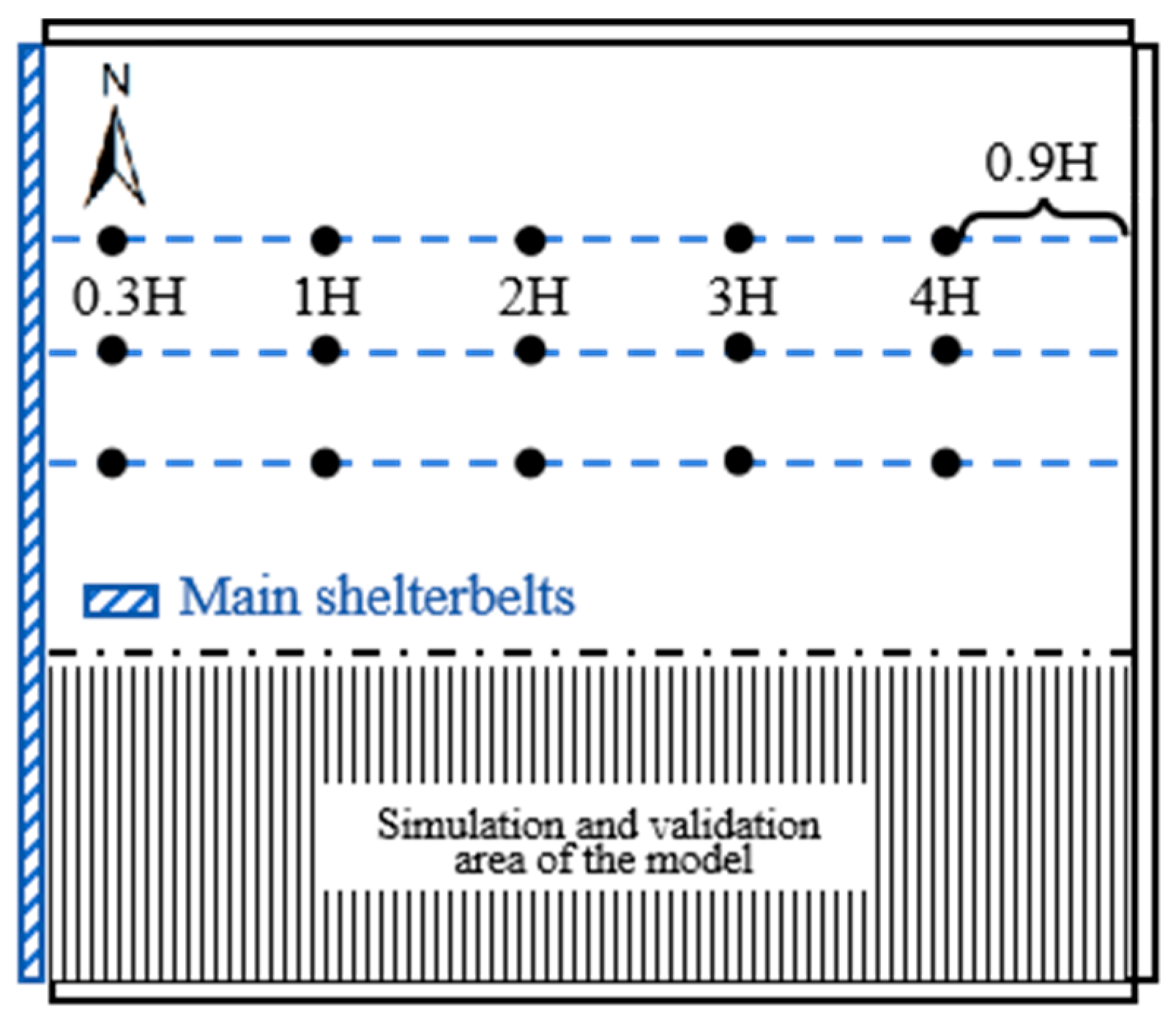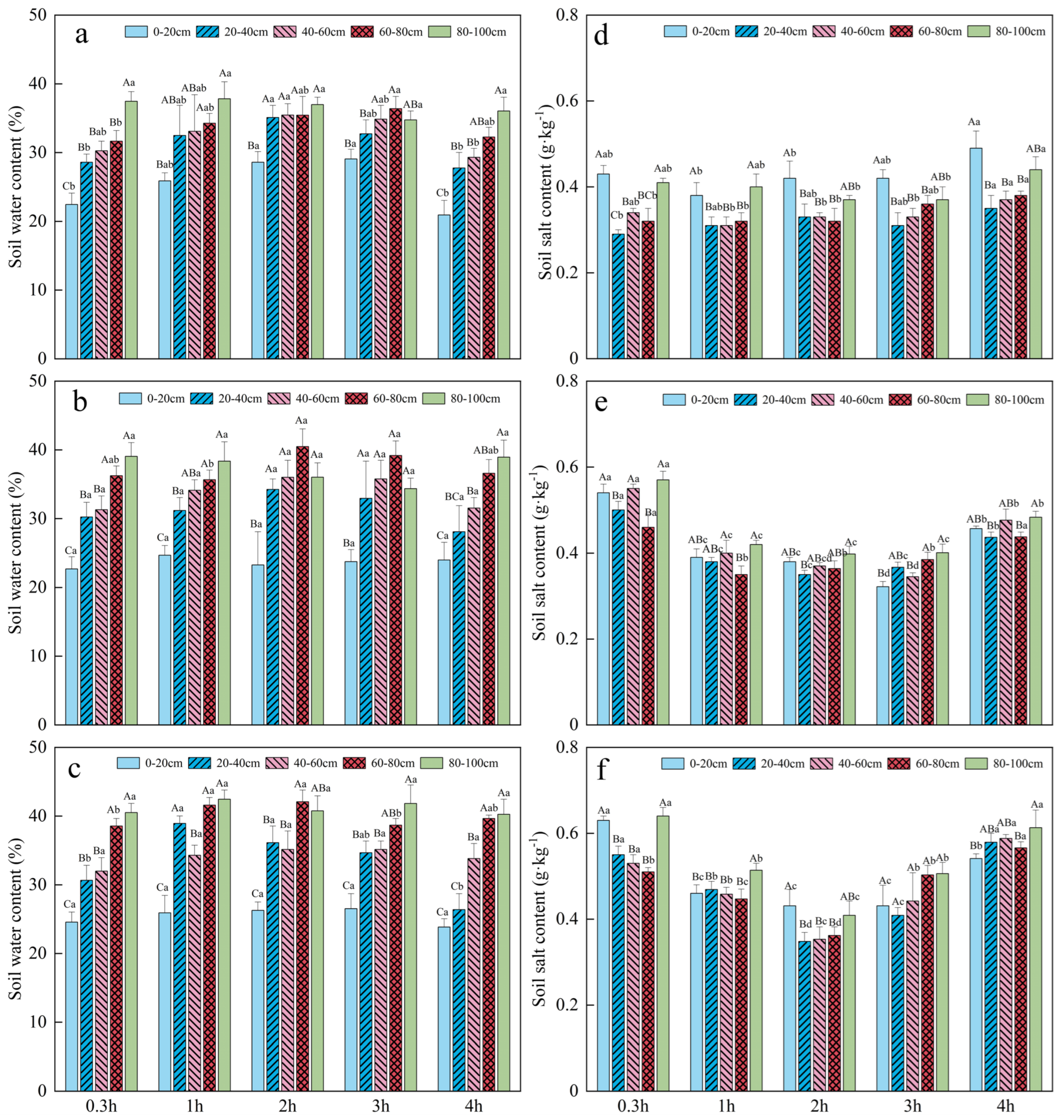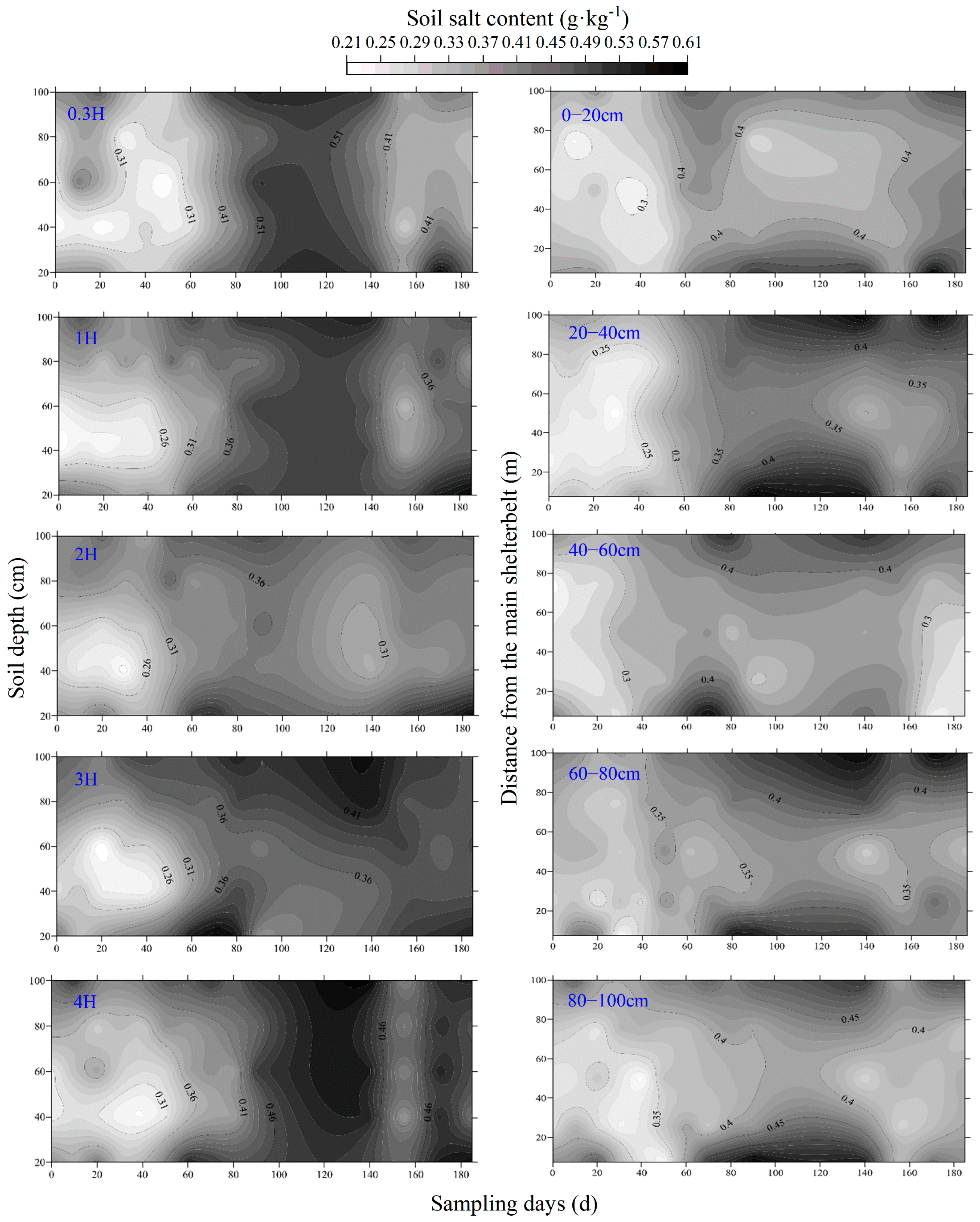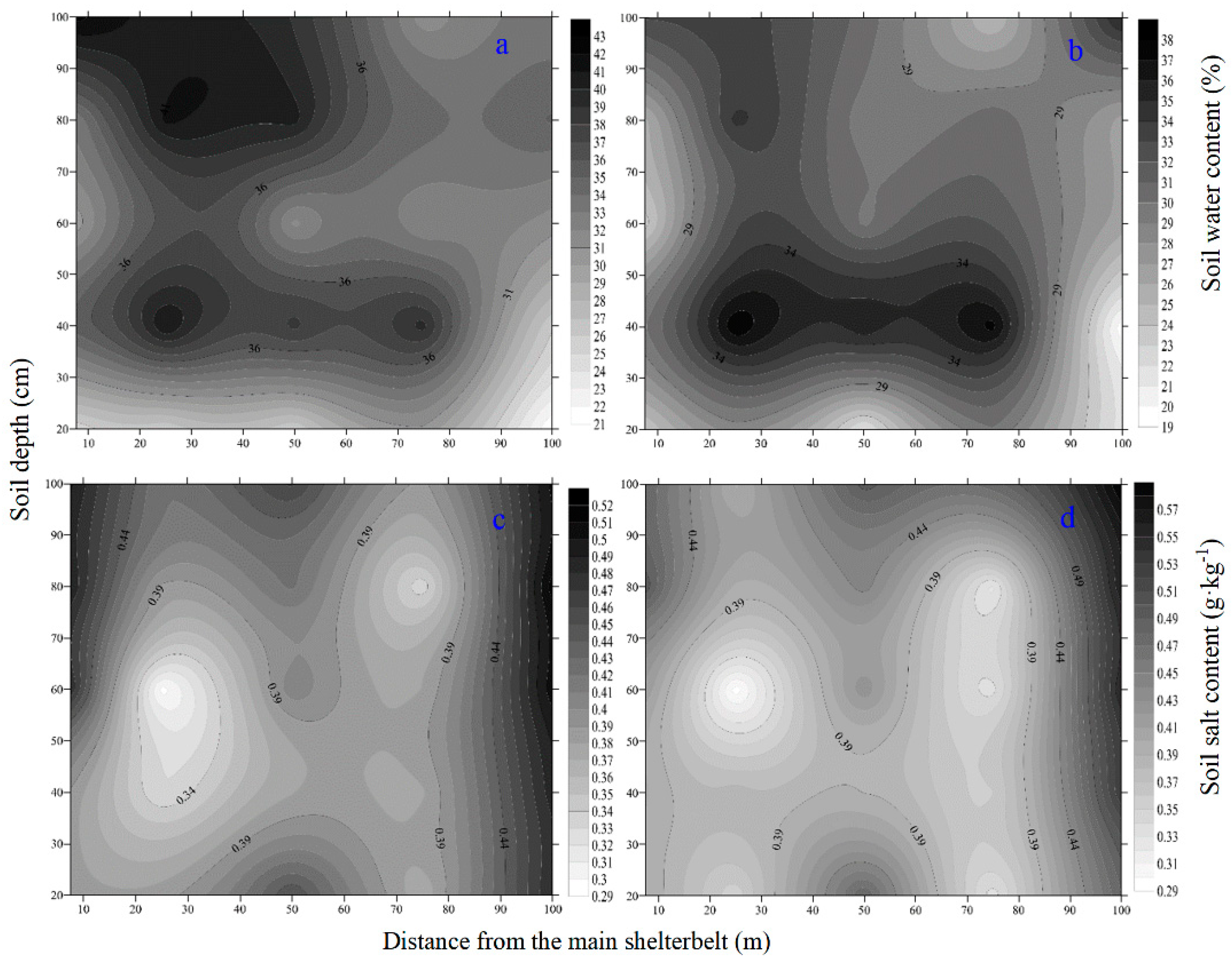Effects of Seasonal Freezing and Thawing on Soil Moisture and Salinity in the Farmland Shelterbelt System in the Hetao Irrigation District
Abstract
1. Introduction
2. Materials and Methods
2.1. Study Area
2.2. Experimental Design
2.3. Data collection and Measurements
2.3.1. Soil Moisture
2.3.2. Soil Salinity
2.3.3. Soil Temperature and Meteorological Index
2.4. Soil Moisture and Salt Prediction Model
2.4.1. Multiple Regression Model
2.4.2. BP neural Network Model
2.5. Data Processing
3. Results
3.1. Soil Freezing and Thawing Process in Farmland Shelterbelt System
3.2. Spatial Distribution of Soil Water and Salt at Critical Points during Freeze–Thaw Period
3.3. Temporal and Spatial Distribution of Farmland Soil Water and Salt in the Protection Forest during the Freeze–Thaw Period
3.3.1. Spatial and Temporal Distribution of Farmland Soil Moisture in the Protection Forest during the Freeze–Thaw Period
3.3.2. Temporal and Spatial Distribution of Farmland Soil Salinity in the Protection Forest during the Freeze–Thaw Period
3.3.3. The Correlation between Soil Moisture and Salinity
3.4. Construction of Soil Water and Salt Prediction Model
3.4.1. Multiple Regression Model
3.4.2. BP Neural Network Model
4. Discussion
4.1. Soil Freezing and Thawing Process
4.2. Soil Water and Salt Migration and Distribution
4.3. Soil Water and Salt Prediction Model
5. Conclusions
Author Contributions
Funding
Data Availability Statement
Acknowledgments
Conflicts of Interest
References
- Zhao, Y.j.; Mao, F.; Yang, X.H. Soil Salinization and Its Improvement in Arid Hetao Plain, Inner Mongolia: Irrigation Roles. Chin. For. Sci. Technol. 2010, 3, 27–35. [Google Scholar]
- Guo, S.S.; Ruan, B.Q.; Chen, H.R.; Guan, X.Y.; Wang, S.L.; Xu, N.N.; Li, Y.P. Characterizing the spatiotemporal evolution of soil salinization in Hetao Irrigation District (China) using a remote sensing approach. Int. J. Remote Sens. 2018, 39, 6805–6825. [Google Scholar] [CrossRef]
- Huang, Q.; Xu, X.; Lü, L.; Ren, D.; Ke, J.; Xiong, Y.; Huo, Z.; Huang, G. Soil salinity distribution based on remote sensing and its effect on crop growth in Hetao Irrigation District. Trans. Chin. Soc. Agric. Eng. 2018, 34, 102–109. [Google Scholar]
- Katekhong, W.; Charoenrein, S. Effect of rice ageing and freeze-thaw cycle on textural properties of cooked rice (Oryza sativa L.) cv. Khao Dawk Mali 105. Int. J. Food Sci. Technol. 2014, 49, 2283–2289. [Google Scholar] [CrossRef]
- Wu, T.; Yu, M.; Wang, G.; Wang, Z.; Duan, X.; Dong, Y.; Cheng, X. Effects of stand structure on wind speed reduction in a Metasequoia glyptostroboides shelterbelt. Agrofor. Syst. 2013, 87, 251–257. [Google Scholar] [CrossRef]
- Cui, L.; Zhao, Y.; Yi, J.; Zhang, J.; Wang, Y.; Wang, Y. Soil Water and Heat Dynamics in Soil Freezing-Thawing Processes of Farmland.Desert Transitional Zone in Middle Reach of Heihe River. Bull. Soil Water Conserv. 2014, 6, 94–100. [Google Scholar]
- Kang, Y.; Chen, M.; Wan, S. Effects of drip irrigation with saline water on waxy maize (Zea mays L. var. ceratina Kulesh) in North China Plain. Agric. Water Manag. 2010, 97, 1303–1309. [Google Scholar]
- Zheng, C. Research on evapotranspiration benefits of farmland protective forests in sandy areas. Sci. Technol. Qinghai Agric. For. 1999, 4, 51. [Google Scholar]
- Guo, Y.; Yin, X.; Li, Y.; Chen, Y.; Cui, M. Soil water and salt dynamics and its coupling model at cropland-treebelt-desert compound system. Trans. Chin. Soc. Agric. Eng. 2019, 35, 87–101. [Google Scholar]
- Wu, Y.Y.; Ma, B.; Jiang, Y. Influence of Typical Desert Farmland Shelter Forest on Soil Water and Salt Dynamics in Cotton Fields. Xinjiang Agric. Sci. 2021, 58, 1012–1020. [Google Scholar]
- Bing, H.; He, P.; Zhang, Y. Cyclic freeze–thaw as a mechanism for water and salt migration in soil. Environ. Earth Sci. 2015, 74, 675–681. [Google Scholar] [CrossRef]
- Zhang, D.; Wang, S. Mechanism of freeze–thaw action in the process of soil salinization in northeast China. Environ. Geol. 2001, 41, 96–100. [Google Scholar] [CrossRef]
- Hu, G.; Zhao, L.; Wu, X.; Wu, T.; Li, R.; Xie, C.; Xiao, Y.; Pang, Q.; Liu, G.; Hao, J.; et al. A mathematical investigation of the air-ground temperature relationship in permafrost regions on the Tibetan Plateau. Geoderma 2017, 306, 244–251. [Google Scholar] [CrossRef]
- Todd, R.; Evett, S.; Howell, T.; Klocke, N. Soil Temperature and Water Evaporation of Small Steel and Plastic Lysimeters Replaced Daily. Soil Sci. 2000, 165, 890–895. [Google Scholar] [CrossRef]
- Rennie, D.A.; Heimo, M. Soil and fertilizer-n transformations under simulated zero till: Effect of temperature regimes. Can. J. Soil Sci. 1984, 1, 1–8. [Google Scholar] [CrossRef]
- Bao, W.; Xie, Y.; Yang, X. A laboratory test study on water and salt migration in natural saline soils and associated shear strength changes under freezing and thawing cycles. J. Eng. Geol. 2006, 3, 380–385. [Google Scholar]
- Zhang, L.; Han, W.; Gu, T. The Influence of Freezing and Thawing on the Moisture-Salt Activity of Soil in Caowotan Basin of Jingdian Irrigated Area. J. Glaciol. Geocryol. 2003, 25, 297–302. [Google Scholar]
- Zhong, Y.Q.; Chen, Y.X.; Shi, H.B.; Wei, Z.M. An Artificial Neural Network Forecast Model for Regional Soil Water-Salt Regime. Irrig. Drain. 2002, 21, 40–44. [Google Scholar]
- Huo, Z.L.; Shi, H.B.; Kong, D.; Zhang, L.H.; Cheng, Y.X.; Wei, Z.M.; Qu, Z.Y. Preliminary Study on Crop-Water-Salt Response with Aritificial Neural Network. J. Inn. Mong. Agric. Univ. 2003, 24, 66–70. [Google Scholar]
- Zheng, D.M.; Xu, L.S.; Luo, J.M.; Bao, C.H. Research on the Water and Salt Dynamics in Salinized Wetlands of Songnen Plain During the Freezing/Thawing Period-Taking the lakebeach in Shisan lake, Changling District as an example. Wetl. Sci. 2005, 3, 48–53. [Google Scholar]
- Hao, K.; Xiao, H.; Xin, Z.; Wang, B.; Cao, Q. The Seasonal Freezing and Thawing Process of the Soil and the Characteristies of Water and Salt Transport in the Farmland Shelter Forest Net in the Hetao lrrigation Distriet. J. Soil Water Conserv. 2022, 36, 231–237. [Google Scholar]
- Flerchinger, G.N.; Saxton, K.E. Simultaneous Heat and Water Model of a Freezing Snow-Residue-Soil System I. Theory and Development. Trans. ASAE 1989, 32, 573–576. [Google Scholar] [CrossRef]
- Coulibaly, P.; Anctil, F.; Aravena, R.; Bobée’, B. Artifcial neural network modeling of water table depth Huctuations. Water Resour. Res. 2001, 37, 885–896. [Google Scholar] [CrossRef]
- Bai, R.Q.; Lai, Y.M.; Zhang, M.Y.; Jiang, H.Y. Investigating the thermo-hydro-mechanical behavior of loess subjected to freeze-thaw cycles. Acta Geotech. 2024. [Google Scholar] [CrossRef]
- Zhang, Y.; Ma, Y.; Zhang, Z.; Gao, H.; Zhai, J. Hillslope patterns in thaw-freeze cycle and hydrothermal regimes on Tibetan Plateau. Chin. Sci. Bull. 2015, 60, 664–673. [Google Scholar]
- Wu, M.; Tan, X.; Huang, J.; Wu, J.; Jansson, P. Solute and water effects on soil freezing characteristics based on laboratory experiments. Cold Reg. Sci. Technol. 2015, 115, 22–29. [Google Scholar] [CrossRef]
- Gan, L.; Peng, X.; Peth, S.; Horn, R. Effects of grazing intensity on soil thermal properties and heat flux under Leymus chinensis and Stipa grandis vegetation in Inner Mongolia, China. Soil Tillage Res. 2012, 118, 147–158. [Google Scholar] [CrossRef]
- Liu, X.; Liu, Q.; Liu, T.; Duan, L.; Yue, C. Rules of the dynamic water heat-salt transfer in soil of Horqin meadow during freezing and thawing period. Adv. Water Sci. 2015, 26, 331–339. [Google Scholar]
- Ala, M.S.; Liu, Y.; Wang, A.Z.; Niu, C.Y. Characteristics of soil freeze-thaw cycles and their effects on water enrichment in the rhizosphere. Geoderma 2016, 264, 132–139. [Google Scholar]
- Wang, L.; Seki, K.; Miyazaki, T.; Ishihama, Y. The causes of soil alkalinization in the Songnen Plain of Northeast China. Paddy Water Environ. 2009, 7, 259–270. [Google Scholar] [CrossRef]
- Zhang, H.; Zhi, B.; Liu, E.L.; Wang, T.H. Study on Varying Characteristics of Temperature Field and Moisture Field of Shallow Loess in the Freeze-Thaw Period. Adv. Mater. Sci. Eng. 2020, 2020, 1690406. [Google Scholar] [CrossRef]
- Shen, Q.; Gao, G.; Fu, B.; Lü, Y. Sap flow and water use sources of shelter-belt trees in an arid inland river basin of Northwest China. Ecohydrology 2015, 8, 1446–1458. [Google Scholar] [CrossRef]
- Yi, J.; Zhao, Y.; Shao, M.A.; Zhang, J.; Cui, L.; Si, B. Soil freezing and thawing processes affected by the different landscapes in the middle reaches of Heihe River Basin, Gansu, China. J. Hydrol. 2014, 519, 1328–1338. [Google Scholar] [CrossRef]
- Nagare, R.M.; Schincariol, R.A.; Quinton, W.L.; Hayashi, M. Laboratory calibration of time domain reflectometry to determine moisture content in undisturbed peat samples. Eur. J. Soil Sci. 2011, 62, 505–515. [Google Scholar] [CrossRef]
- Wang, T.; Li, P.; Li, Z.B.; Hou, J.M.; Xiao, L.; Ren, Z.P.; Xu, G.C.; Yu, K.X.; Su, Y.Y. The effects of freeze-thaw process on soil water migration in dam and slope farmland on the Loess Plateau, China. Sci. Total Environ. 2019, 666, 721–730. [Google Scholar] [CrossRef] [PubMed]
- Wu, D.; Zhou, X.; Jiang, X. Water and Salt Migration with Phase Change in Saline Soil during Freezing and Thawing Processes. Groundwater 2017, 56, 742–752. [Google Scholar] [CrossRef] [PubMed]
- Guo, K.; Liu, X.R. Salt leaching process in coastal saline soil by infiltration of melting saline ice under field conditions. J. Soil Water Conserv 2020, 75, 549–562. [Google Scholar] [CrossRef]
- Oogathoo, S.; Duchesne, L.; Houle, D.; Kneeshaw, D.; Bélanger, N. Precipitation and relative humidity favours tree growth while air temperature and relative humidity respectively drive winter stem shrinkage and expansion. Front. For. Glob. Change 2024, 7, 1368590. [Google Scholar] [CrossRef]
- Zhang, H.B.; Wang, J.; Liu, Z.K.; Ma, C.Y.; Song, Z.S.; Cui, F.; Wu, J.Q.; Song, X.G. Strength characteristics of foamed concrete under coupling effect of constant compressive loading and freeze-thaw cycles. Constr. Build. Mater. 2024, 411, 134565. [Google Scholar] [CrossRef]
- Jin, J.X.; Zhang, X.L.; Liu, X.L.; Li, Y.H.; Li, S.H. Study on critical slowdown characteristics and early warning model of damage evolution of sandstone under freeze-thaw cycles. Front. Earth Sci. 2023, 10, 1006642. [Google Scholar] [CrossRef]
- Lyu, H.; Li, H.; Zhang, P.; Cheng, C.; Zhang, H.; Wu, S.S.; Ma, Q.C.; Su, X.S. Response mechanism of groundwater dynamics to Freeze-thaw process in seasonally frozen soil areas: A comprehensive analysis from site to regional scale. J. Hydrol. 2023, 625, 129861. [Google Scholar] [CrossRef]








| Soil Layer (cm) | 0–20 | 20–40 | 40–60 | 60–80 | 80–100 | 0–100 (Mean) |
|---|---|---|---|---|---|---|
| Correlation coefficient | −0.95 * | −0.99 ** | −0.99 ** | −0.58 | −0.03 | −0.99 ** |
Disclaimer/Publisher’s Note: The statements, opinions and data contained in all publications are solely those of the individual author(s) and contributor(s) and not of MDPI and/or the editor(s). MDPI and/or the editor(s) disclaim responsibility for any injury to people or property resulting from any ideas, methods, instructions or products referred to in the content. |
© 2024 by the authors. Licensee MDPI, Basel, Switzerland. This article is an open access article distributed under the terms and conditions of the Creative Commons Attribution (CC BY) license (https://creativecommons.org/licenses/by/4.0/).
Share and Cite
Luo, C.; Wang, R.; Hao, K.; Jia, X.; Zhu, J.; Xin, Z.; Xiao, H. Effects of Seasonal Freezing and Thawing on Soil Moisture and Salinity in the Farmland Shelterbelt System in the Hetao Irrigation District. Agronomy 2024, 14, 1425. https://doi.org/10.3390/agronomy14071425
Luo C, Wang R, Hao K, Jia X, Zhu J, Xin Z, Xiao H. Effects of Seasonal Freezing and Thawing on Soil Moisture and Salinity in the Farmland Shelterbelt System in the Hetao Irrigation District. Agronomy. 2024; 14(7):1425. https://doi.org/10.3390/agronomy14071425
Chicago/Turabian StyleLuo, Chengwei, Ruoshui Wang, Kexin Hao, Xiaoxiao Jia, Junying Zhu, Zhiming Xin, and Huijie Xiao. 2024. "Effects of Seasonal Freezing and Thawing on Soil Moisture and Salinity in the Farmland Shelterbelt System in the Hetao Irrigation District" Agronomy 14, no. 7: 1425. https://doi.org/10.3390/agronomy14071425
APA StyleLuo, C., Wang, R., Hao, K., Jia, X., Zhu, J., Xin, Z., & Xiao, H. (2024). Effects of Seasonal Freezing and Thawing on Soil Moisture and Salinity in the Farmland Shelterbelt System in the Hetao Irrigation District. Agronomy, 14(7), 1425. https://doi.org/10.3390/agronomy14071425




